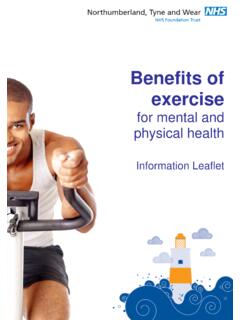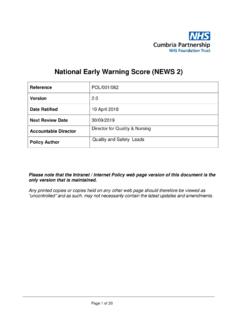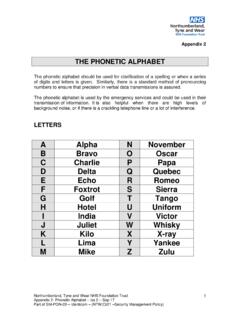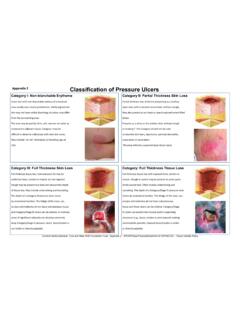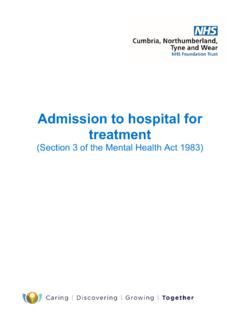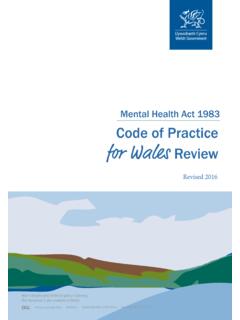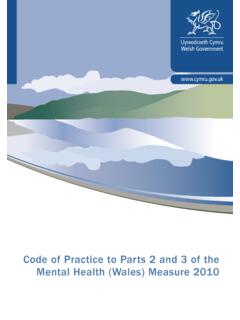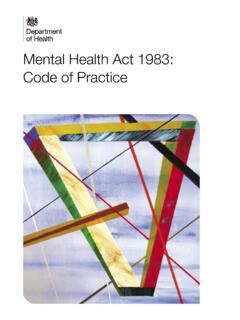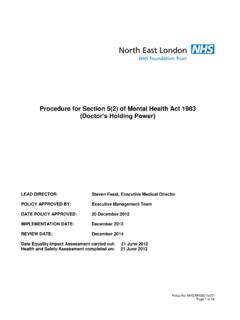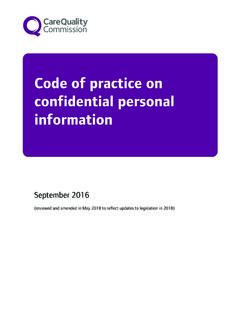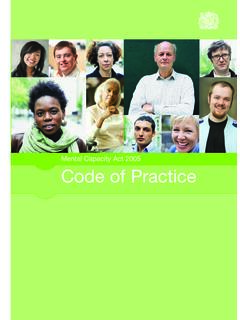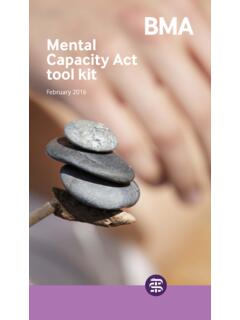Transcription of Chapter 19 Mental Health Act 1983; Code of Practice 2015 ...
1 NTW (C) 08. Appendix 1. Chapter 19 Mental Health Act 1983 ; code of Practice 2015. Children and Young People under the age of 18. Why read this Chapter ? Particular issues arise in relation to children (under 16 years of age) and young people (16 or 17 years old). In addition to the Act, other relevant legislation includes the Children Acts 1989 and 2004, the Mental Capacity Act (MCA) 2005 and the Human Rights Act (HRA) 1998. Professionals, practitioners and others responsible for the care of children and young people should be familiar with this legislation.
2 This Chapter provides guidance on the role of those with parental responsibility for a child or young person; confidentiality and sharing information; how children and young people should be safeguarded where admission to hospital is not appropriate and on decisions related to admission and treatment. It should be read in conjunction with other chapters in this code . This Chapter sets out some of the key factors including: some of the main concepts to be considered when providing care and treatment to children and young people, such as parental responsibility' and decisions within the scope of parental responsibility'1.
3 Assessing the competence of children and the capacity of young people to make decisions about their admission and/or treatment when informal admission might be appropriate and when the Mental Health Act 1983 (the Act) should be used specific provisions relating to the treatment of children and young people under the Act the duty to provide age appropriate services applications and references to the Tribunal, and general duties of local authorities in relation to children and young people in hospital. General considerations In addition to the Act, those responsible for the care of children and young people in hospital should be familiar with other relevant legislation, including the Children Acts 1989 and 2004, the MCA and the HRA.
4 They should also be aware of the United Nations Convention on the Rights of the Child (UNCRC), and keep up-to-date with relevant case law and guidance. When making decisions in relation to the care and treatment of children and young people, practitioners should keep the following points in mind: the best interests of the child or young person must always be a significant consideration Northumberland, Tyne and Wear NHS Foundation Trust 1. Appendix 1 Chapter 19 - MHA83; code of Practice 2015 - CYPS under the age of 18-V04-Iss1-Feb16. Part of NTW(C)08 Young People Requiring Admission to Hospital NTW (C) 08.
5 Everyone who works with children has a responsibility for keeping them safe and to take prompt action if welfare needs or safeguarding concerns are identified all practitioners and agencies are expected to contribute to whatever actions are needed to safeguard and promote a child or young person's welfare the developmental process from childhood to adulthood, particularly during adolescence, involves significant changes in a wide range of areas, such as physical, emotional and cognitive development these factors need to be taken into account, in addition to the child and young person's personal circumstances, when assessing whether a child or young person has a Mental disorder children and young people should always be kept as fully informed as possible and should receive clear and detailed information concerning their care and treatment, explained in a way they can understand and in a format that is appropriate to their age the child or young person's views, wishes and feelings should always be sought.
6 Their views taken seriously and professionals should work with them collaboratively in deciding on how to support that child or young person's needs any intervention in the life of a child or young person that is considered necessary by reason of their Mental disorder should be the least restrictive option and the least likely to expose them to the risk of any stigmatisation, consistent with effective care and treatment, and it should also result in the least possible separation from family, carers, friends and community or interruption of their education where hospital admission is necessary, the child or young person should be placed as near to their home as reasonably practicable, recognising that placement further away from home increases the separation between the child or young person and their family, carers, friends, community and school all children and young people should receive the same access to educational provision as their peers children and young people have as much right to expect their dignity to be respected as anyone else.
7 And children and young people have as much right to privacy and confidentiality as anyone else. People with parental responsibility Those with parental responsibility have a central role in relation to decisions about the admission and treatment of their child (see paragraphs below). It is therefore essential that those proposing the admission and/or treatment identify who has parental responsibility. Northumberland, Tyne and Wear NHS Foundation Trust 2. Appendix 1 Chapter 19 - MHA83; code of Practice 2015 - CYPS under the age of 18-V04-Iss1-Feb16. Part of NTW(C)08 Young People Requiring Admission to Hospital NTW (C) 08.
8 Those with parental responsibility will usually, but not always, be the parents of the child or young person. Other people may also acquire parental responsibility. Where the parents are not married, it will be necessary to ascertain whether the father has gained parental responsibility (this might be by a court order, parental responsibility agreement, or (since 1st December 2003) as a result of the father registering his child's birth jointly with the child's mother).2 The question whether the father has acquired parental responsibility will also be relevant when ascertaining who is the nearest relative under the Act3 (see paragraph above in Chapter 5).
9 Those taking decisions under the Act must be clear about who has parental responsibility. When seeking to identify who has parental responsibility for the child or young person, practitioners should always check whether the child or young person's medical and/or social service files include any relevant court orders, and request copies of any such orders. These orders may include care orders, child arrangements orders (which replace residence orders and contact orders),4 special guardianship orders, evidence of appointment as the child or young person's guardian, parental responsibility agreements or orders under section 4 of the Children Act 1989 and any order under wardship.
10 Practitioners should always check with those caring for the child or young person whether any child arrangements orders, parental responsibility agreements or orders, or special guardianship orders have been obtained. Where the parents of a child or young person (both of whom have parental responsibility), are separated and the child or young person is living with one parent in accordance with a child arrangements order (formerly known as a residence order), practitioners should be aware that the parents continue to share parental responsibility and both should be involved in making decisions about their child.
